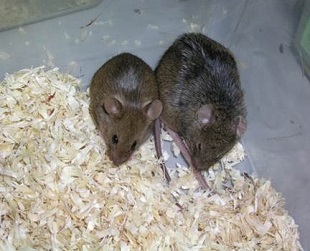糖尿病予備軍モデルマウスの開発

メンバー: 斉藤美佳子
分野: 実験動物学、生物科学、境界農学
所属: 工学研究院生命機能科学部門
キーワード: 疾患モデル細胞、細胞再生工学、糖尿病予備軍モデル、細胞医薬
ウェブサイト:
研究概要

現在、糖尿病予備軍の人口数が増加しており、糖尿病の発症予防や治療薬開発は必須の課題となっています。私達は、境界型糖尿病モデルマウスであるGKKO(+/–)マウスを開発しました。
グルコキナーゼ遺伝子(Gk)が全身的にヘテロノックアウトされたGk(+/–)マウスを作製するためにGkのエキソンIIを除去しました。心臓、肺、肝臓、胃、膵臓におけるGkの発現レベルは、野生型のGk(+/+)マウスの場合に比べて0.41~0.68です。一方、脳、脂肪組織、筋肉では、0.95~1.03であり、脾臓、腎臓ではほとんど0です。Gkノックアウトによって、他の7種類(Shp, Hnf1a, Hnf1b, Irs1, Irs2, Kir6.2, and Pdx1)の糖尿病関連遺伝子の10種類の臓器における遺伝子発現に対するオフターゲット効果は認められません。耐糖能試験を行い、24時間絶食後の血糖値(FBG)と、糖添加後2時間の血糖値(GTT2h)を求めたところ、通常食の野生型マウス、通常食のGk(+/–)マウス、高脂肪食のGk(+/–)マウスについて得たFBG-GTT2hの値のプロットは、FBG-GTT2h別々の領域に分布しました。各領域は、それぞれ通常状態、糖尿病予備軍状態、糖尿病状態と定義することができ、この結果に基づき、私達が開発したGk(+/–)マウスに対する、糖尿病予備軍の実験的基準を定義することができました。
この糖尿病予備軍モデルマウスに、私達が開発した方法に基づきES細胞からインスリン分泌細胞へ分化させた細胞を移植したところ、移植した細胞が糖尿病予備軍モデルマウスに生着してインスリンを分泌し、長期間に渡って血糖値を改善することができました。
糖尿病予備軍モデルマウスは、糖尿病の研究や治療薬の開発に非常に有用です。
主要論文・参考事項
(1) Mikako Saito, Asako Kaneda, Hajime Shigeto, Nobuaki Hanata, Keiko Otokuni and Hideaki Matsuoka, "Development of an optimized 5-stage protocol for the in vitro preparation of insulin-secreting cells from mouse ES cells", Cytotechnology, in press.
(2) Mikako Saito, Asako Kaneda, Tae Sugiyama, Ryousuke Iida, Keiko Otokuni, Misako Kaburagi and Hideaki Matsuoka, "Production of a mouse strain with impaired glucose tolerance by systemic heterozygous knockout of the glucokinase gene and its feasibility as a prediabetes model", Exp. Anim., 64(3), 231-239 (2015).
(3) Mikako Saito, Natsuki Abe, Ayano Ishida, Shota Nakagawa and Hidekia Matsuoka, "Concentration-dependent effects of spermine on apoptosis and consequent generation of multilayer myotube sheets from mouse embryoid bodies in vitro", In Vitro Cell. Dev. Biol.-Anim., 50(10), 973-981 (2014).
(4) Kenji Sakuma, Susumu Hayashi, Keiko Otokuni, Izumi Matsumoto, Hideaki Matsuoka and Mikako Saito, "Standard operating procedures for maintaining cleanliness in a novel compact facility for breeding SPF mice", J. Amer. Assoc. Lab. Anim. Sci., 52(6), 717-724 (2013).
(5) Mikako Saito, Yukari Kakutani, Misako Kaburagi, Hisakage Funabashi and Hideaki Matsuoka, "Development of a protocol for selection of genes fit for the in vivo knockdown method and its application to insulin receptor substrate genes in mice", Exp. Anim., 62(2), 117-125 (2013).
(6) Kenji Sakuma, Susumu Hayashi, Yoshiyuki Yasaka, Hiroto Nishijima, Hisakage Funabashi, Masayoshi Hayashi, Hideaki Matsuoka and Mikako Saito, "Analysis of odor compounds in feces of mice that were exposed to various stresses during breeding", Exp. Anim., 62(2), 101-107 (2013).
(7) Mikako Saito, Aya Hayakawa, Nobuya Inagaki and Hideaki Matsuoka, "Development of novel cell lines of diabetic dysfunction model fit for cell-based screening tests of medicinal materials", Cytotechnology, 65(1), 105-118 (2013).
お問い合わせ先
東京農工大学・先端産学連携研究推進センター
urac[at]ml.tuat.ac.jp([at]を@に変換してください)
Production of prediabetes model mice

Research members: Mikako Saito PhD.
Research fields: Laboratory animal science, Biological Science, Boundary agriculture
Departments: Department of Biotechnology and Life Science, Institute of Engineering
Keywords: Disease model cell,Cell regenerative technology,Prediabetes model mouse,cell medicine
Web site:
Summary

Exon II of glucokinase (Gk) was deleted to produce a systemic heterozygous Gk knockout (Gk+/−) mouse. The relative expression levels of Gk in the heart, lung, liver, stomach, and pancreas in Gk+/− mice ranged from 0.41–0.68 versus that in wild (Gk+/+) mice. On the other hand, its expression levels in the brain, adipose tissue, and muscle ranged from 0.95–1.03, and its expression levels in the spleen and kidney were nearly zero. Gk knockout caused no remarkable off-target effect on the expression of 7 diabetes causing genes (Shp, Hnf1a, Hnf1b, Irs1, Irs2, Kir6.2, and Pdx1) in 10 organs.
The glucose tolerance test was conducted to determine the blood glucose concentrations just after fasting for 24 h (FBG) and at 2 h after high-glucose application (GTT2h). The FBG-GTT2h plots obtained with the wild strain fed the control diet (CD), Gk+/− strain fed the CD, and Gk+/− strain fed the HFD were distributed in separate areas in the FBG-GTT2h diagram. The respective areas could be defined as the normal state, prediabetes state, and diabetes state, respectively. Based on the results, the criteria for prediabetes could be defined for the Gk+/− strain developed in this study.
The differentiated insulin-secreting cells from mouse ES cells were transplanted in prediabetes model mice. The transplantation of 5×106 cells resulted marked improvement of glucose tolerance within 20 days. This effect decreased but still observed at 120 days post-transplantation.
This would be of great importance from the viewpoint of use of the prediabetes model in studies of various factors inducing diabetes and other diseases.
Reference articles and patents
(1) Mikako Saito, Asako Kaneda, Hajime Shigeto, Nobuaki Hanata, Keiko Otokuni and Hideaki Matsuoka, "Development of an optimized 5-stage protocol for the in vitro preparation of insulin-secreting cells from mouse ES cells", Cytotechnology, in press.
(2) Mikako Saito, Asako Kaneda, Tae Sugiyama, Ryousuke Iida, Keiko Otokuni, Misako Kaburagi and Hideaki Matsuoka, "Production of a mouse strain with impaired glucose tolerance by systemic heterozygous knockout of the glucokinase gene and its feasibility as a prediabetes model", Exp. Anim., 64(3), 231-239 (2015).
(3) Mikako Saito, Natsuki Abe, Ayano Ishida, Shota Nakagawa and Hidekia Matsuoka, "Concentration-dependent effects of spermine on apoptosis and consequent generation of multilayer myotube sheets from mouse embryoid bodies in vitro", In Vitro Cell. Dev. Biol.-Anim., 50(10), 973-981 (2014).
(4) Kenji Sakuma, Susumu Hayashi, Keiko Otokuni, Izumi Matsumoto, Hideaki Matsuoka and Mikako Saito, "Standard operating procedures for maintaining cleanliness in a novel compact facility for breeding SPF mice", J. Amer. Assoc. Lab. Anim. Sci., 52(6), 717-724 (2013).
(5) Mikako Saito, Yukari Kakutani, Misako Kaburagi, Hisakage Funabashi and Hideaki Matsuoka, "Development of a protocol for selection of genes fit for the in vivo knockdown method and its application to insulin receptor substrate genes in mice", Exp. Anim., 62(2), 117-125 (2013).
(6) Kenji Sakuma, Susumu Hayashi, Yoshiyuki Yasaka, Hiroto Nishijima, Hisakage Funabashi, Masayoshi Hayashi, Hideaki Matsuoka and Mikako Saito, "Analysis of odor compounds in feces of mice that were exposed to various stresses during breeding", Exp. Anim., 62(2), 101-107 (2013).
(7) Mikako Saito, Aya Hayakawa, Nobuya Inagaki and Hideaki Matsuoka, "Development of novel cell lines of diabetic dysfunction model fit for cell-based screening tests of medicinal materials", Cytotechnology, 65(1), 105-118 (2013).
Contact
University Research Administration Center (URAC),
Tokyo University of Agriculture and Technology
urac[at]ml.tuat.ac.jp
(Please replace [at] with @.)

